Examples Of B2B Saas
Explore top B2B SaaS platforms that drive business efficiency with cloud-based solutions, from CRM to financial management tools.
Examples Of B2B Saas
B2B SaaS platforms help businesses operate more efficiently, offering scalable, cloud-based solutions without the need for expensive infrastructure. From managing customer relationships to improving team collaboration, these tools address key business challenges and drive growth. Below are six key examples of successful B2B SaaS companies and their standout features:
- Salesforce: CRM platform with AI tools and extensive integrations, boosting sales productivity by 25%.
- HubSpot: All-in-one marketing and sales platform with automation and analytics tools.
- Atlassian: Team collaboration tools like Jira and Confluence, trusted by 83% of Fortune 500 companies.
- Slack: Workplace communication tool with 2,400+ integrations and advanced search capabilities.
- Xero: Accounting software for small businesses with flexible pricing and automated processes.
- QuickBooks: Financial management platform with AI-powered cash flow forecasting.
Quick Comparison
| Company | Core Solution | Key Feature | Target Audience |
|---|---|---|---|
| Salesforce | CRM | AI-driven insights | Medium to large businesses |
| HubSpot | Marketing & Sales | Unified platform | Small to medium businesses |
| Atlassian | Team Collaboration | Agile workflows | Teams and enterprises |
| Slack | Communication | Centralized integrations | Remote and hybrid teams |
| Xero | Accounting | Unlimited user access | Small businesses |
| QuickBooks | Financial Management | AI cash flow forecasting | Small to medium businesses |
These companies demonstrate how SaaS solutions can simplify operations, improve productivity, and meet specific business needs. Whether you’re looking for CRM, marketing, collaboration, or financial tools, these platforms offer practical options for businesses of all sizes.
HubSpot vs Salesforce: Comprehensive Comparison Guide
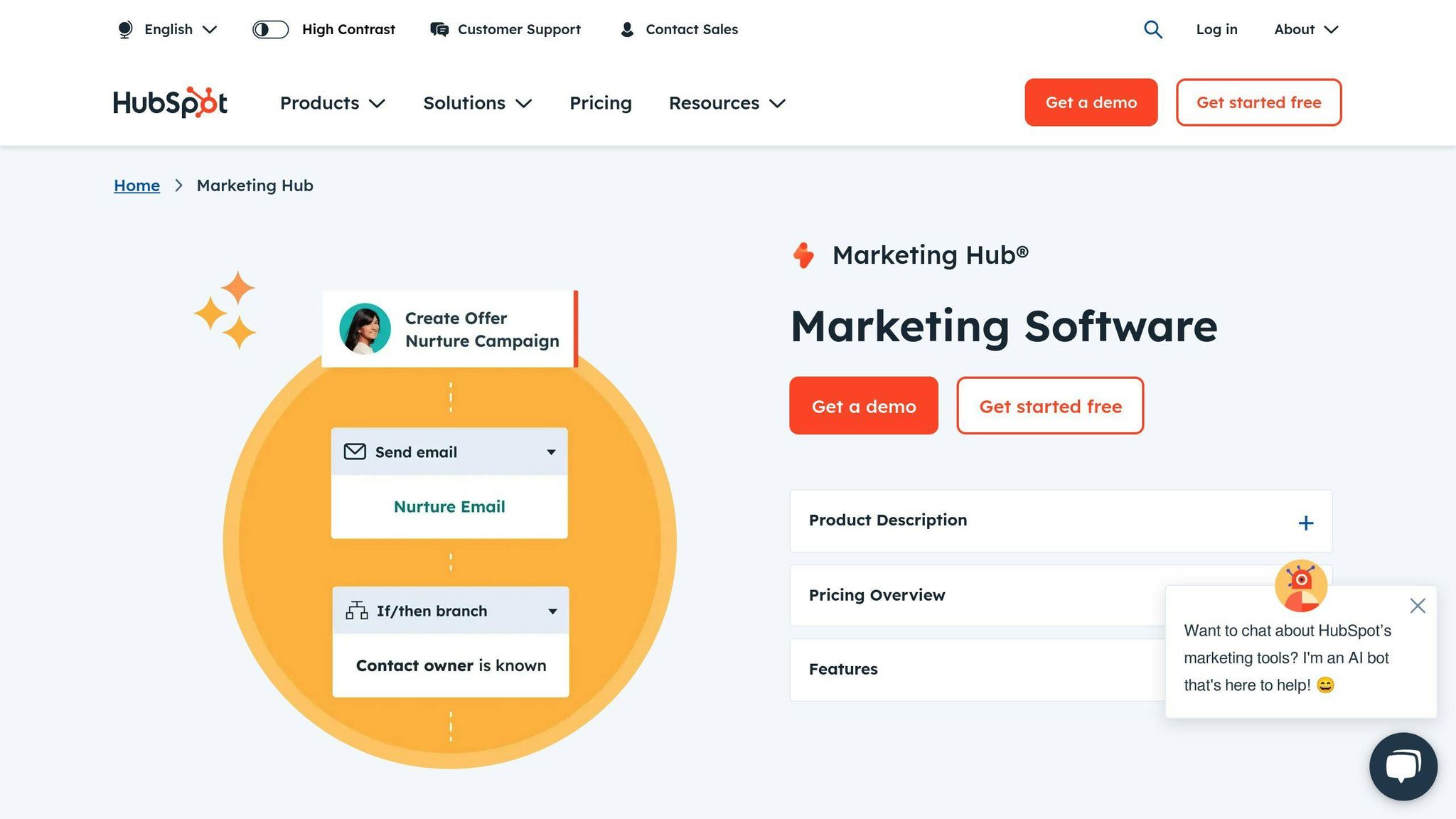
1. Salesforce: A Leader in CRM Solutions
Salesforce stands out as a prime example of B2B SaaS success. Known for its early adoption of cloud computing, Salesforce has changed the way businesses handle customer relationships with its wide range of tools.
The platform combines sales automation, marketing features, and customer support into one cloud-based system, allowing departments to share data effortlessly. Companies using Salesforce have reported a 25% increase in sales productivity, a 30% boost in customer satisfaction, and real-time access to data through more than 1,000 app integrations.
Big names like Coca-Cola and Toyota highlight Salesforce's impact. Coca-Cola improved its sales processes, while Toyota streamlined customer interactions across its dealerships. With AI-driven tools such as predictive analytics, automated lead scoring, and intelligent insights, Salesforce helps businesses personalize their approach and improve forecasting.
For small and medium-sized businesses, Salesforce Essentials provides key CRM tools at a budget-friendly price, offering enterprise-level capabilities without unnecessary complexity.
"Customer-centricity and innovation drive our success, helping businesses transform relationships through data insights and strategic partnerships", says Salesforce's leadership team.
This showcases how integrating tools and using AI can fuel customer-focused growth. While Salesforce dominates in CRM, platforms like HubSpot offer a broader mix of tools for marketing and sales integration.
2. HubSpot: All-in-One Marketing and Sales Platform
HubSpot has become a major player in the B2B SaaS world, achieving over $1 billion in annual revenue and serving 100,000 paying customers. It offers a unified platform that combines marketing, sales, and customer service tools to tackle key business challenges.
With AI-driven features, HubSpot simplifies marketing and sales processes. Tools like the AI Content Writer make content creation and distribution easier, while machine learning provides insights to fine-tune campaigns.
Here's how HubSpot's tools translate into business results:
| Feature | Business Benefit |
|---|---|
| Marketing Hub | Automates campaigns and generates leads |
| Sales Hub | Simplifies pipeline management and deal tracking |
| Service Hub | Improves customer support and satisfaction |
| CMS Hub | Centralizes content creation and distribution |
| Operations Hub | Connects data across teams |
| Marketing Automation | Boosts lead nurturing and conversions |
| CRM Integration | Provides a unified view of customer data |
| Analytics Tools | Tracks ROI and performance effectively |
Take TrustPilot as an example. They revamped their lead generation process using HubSpot’s Marketing Hub, leveraging automated workflows and personalized engagement to drive results.
"Customer-centric approach, automation, and data-driven decision-making are the cornerstones of modern marketing and sales success", says HubSpot's leadership team.
While HubSpot focuses on blending marketing and sales tools, Atlassian takes a different route by prioritizing team collaboration, addressing another essential business need.
3. Atlassian: Tools for Team Collaboration
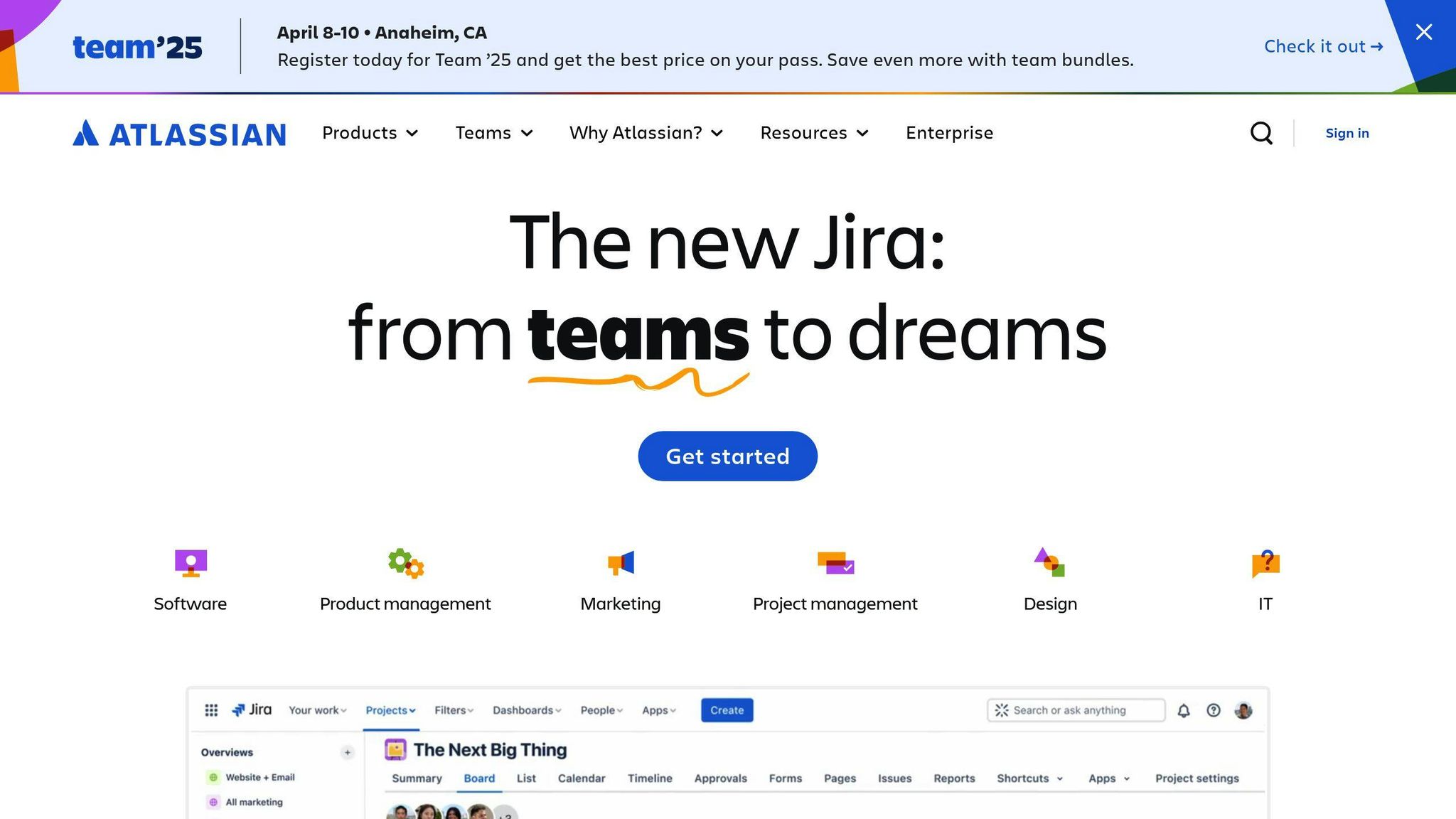
Atlassian has become a major player in the B2B SaaS world, boasting over 180,000 customers and being trusted by 83% of Fortune 500 companies. Its success lies in its suite of collaborative tools, with Jira for project management and Confluence for knowledge sharing at the core.
Jira and Confluence work together to create an ecosystem designed for Agile workflows and team collaboration. Jira stands out with a functional score of 39 out of 45, offering advanced tools for tracking projects and generating reports. Confluence complements Jira by acting as a central hub where teams can create, share, and manage information effectively.
Audi is a great example of how Atlassian's tools can transform operations. Martin Binder, a Business Analyst at Audi, shared:
"People are practicing more knowledge-sharing than ever before, resulting in more transparency and efficiency".
HubSpot also highlights the benefits of using Atlassian. Katie Burke, Chief People Officer at HubSpot, said:
"Information is available to every person in the organization from their very first day. HubSpot Confluence pages are open for anyone to discover, read, and comment on".
Atlassian's transparent pricing and self-serve model have also played a key role in its growth. These features have allowed the company to keep sales and marketing expenses low, consuming just 19% of revenue at the time of its IPO. This approach has been especially useful for organizations adapting to remote work, enabling smooth collaboration and information sharing across dispersed teams.
While Atlassian excels in project management and team collaboration, Slack focuses on taking workplace communication to another level.
4. Slack: Simplifying Workplace Communication
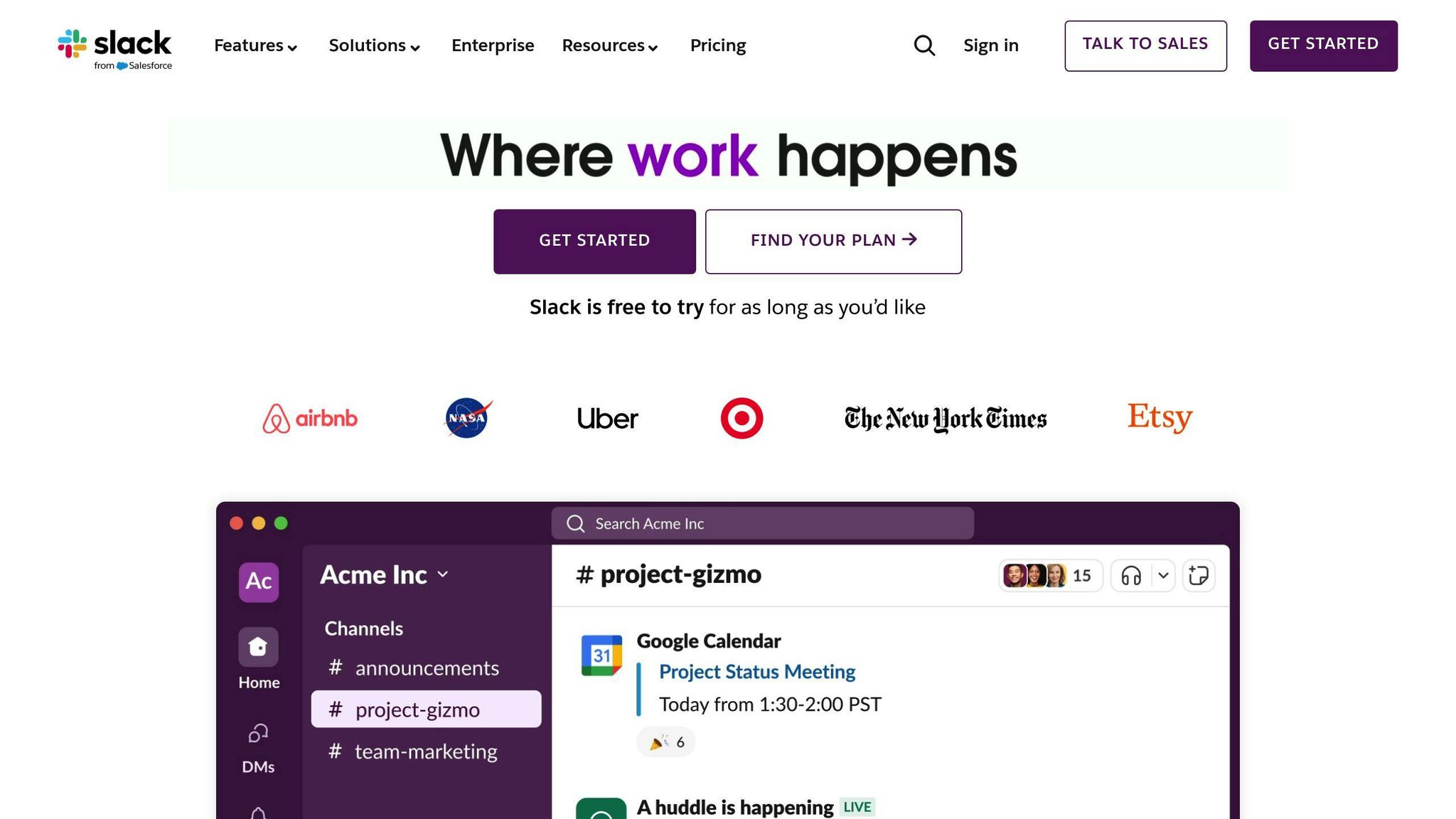
Slack has become a game-changer in workplace communication, now serving over 20 million daily active users and establishing itself as a key tool for modern business collaboration. Interestingly, Slack's journey began as a failed gaming company before pivoting into the communication space, where it now solves common workplace challenges.
With over 2,400 third-party integrations, Slack streamlines workflows by consolidating communications and notifications into a single platform. This integration network helps businesses boost team efficiency by keeping everything centralized and easy to manage.
Slack's growth speaks volumes - its revenue skyrocketed from $12M in 2013 to $4.22B in 2024. One reason for this success is its user-friendly design, which encourages teams to adopt it naturally without heavy sales efforts. It’s especially popular among large enterprises, with 65 companies from the Fortune 100 using Slack to improve their communication. For instance, Accenture built a global employee community on Slack, cutting down email traffic by combining multiple communication channels into one.
The platform also uses AI to make workflows smoother. AI-powered tools handle tasks like automating repetitive inquiries, improving search capabilities, and managing routine questions through chatbots. These features save time and make operations more efficient, whether it’s IT support or HR-related questions.
For larger organizations, Slack Enterprise Grid offers advanced security and scalability while keeping the interface simple and user-friendly. As remote work and digital tools become more critical, Slack’s solutions align well with these shifts. Notably, its 536% 5-year search growth highlights how essential it has become in today’s workplace.
sbb-itb-0499eb9
5. Xero: Accounting Software for Small Businesses
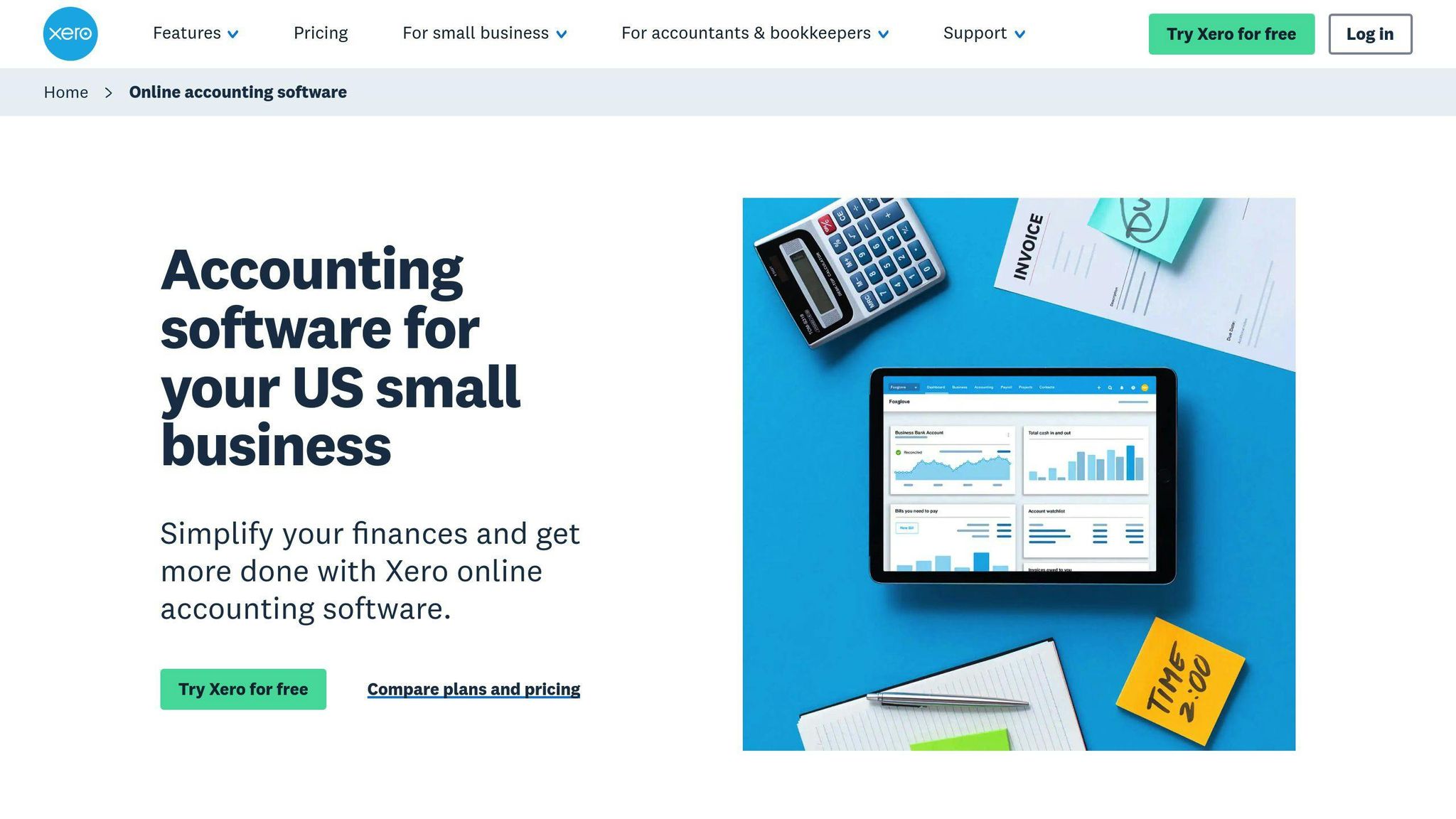
Xero is a cloud-based accounting platform trusted by over 2 million subscribers worldwide. Designed with small businesses in mind, it offers easy-to-use tools, automation features, and integrations with more than 1,000 business apps. For example, by connecting with Dext Prepare, users can snap a photo of a receipt, and the data will be automatically imported into Xero - saving time and reducing manual work.
Xero's pricing plans cater to businesses at various growth stages, offering flexibility and a range of features:
| Plan | Monthly Cost | Key Features |
|---|---|---|
| Early | $13 | Basic reporting, bank reconciliation |
| Growing | $37 | Unlimited invoices, advanced reporting |
| Established | $70 | Multi-currency, project tracking |
One feature that stands out is Xero's unlimited user access, available across all plans. This is particularly useful for growing businesses or remote teams. Another game-changer is its batch payment scheduling, which allows users to plan multiple payments ahead of time - making vendor management smoother and improving supplier relationships.
Portt & Co emphasizes Xero's impact:
"With Xero, everyday financial tasks are simplified so that business owners, accountants and bookkeepers can seamlessly share real-time data."
Xero also uses cloud technology to provide real-time bank feeds and automated reconciliation, keeping financial records accurate with minimal effort. For international businesses, the Established plan supports transactions in over 160 currencies and includes automatic exchange rate updates.
6. Intuit QuickBooks: Simplifying Financial Management
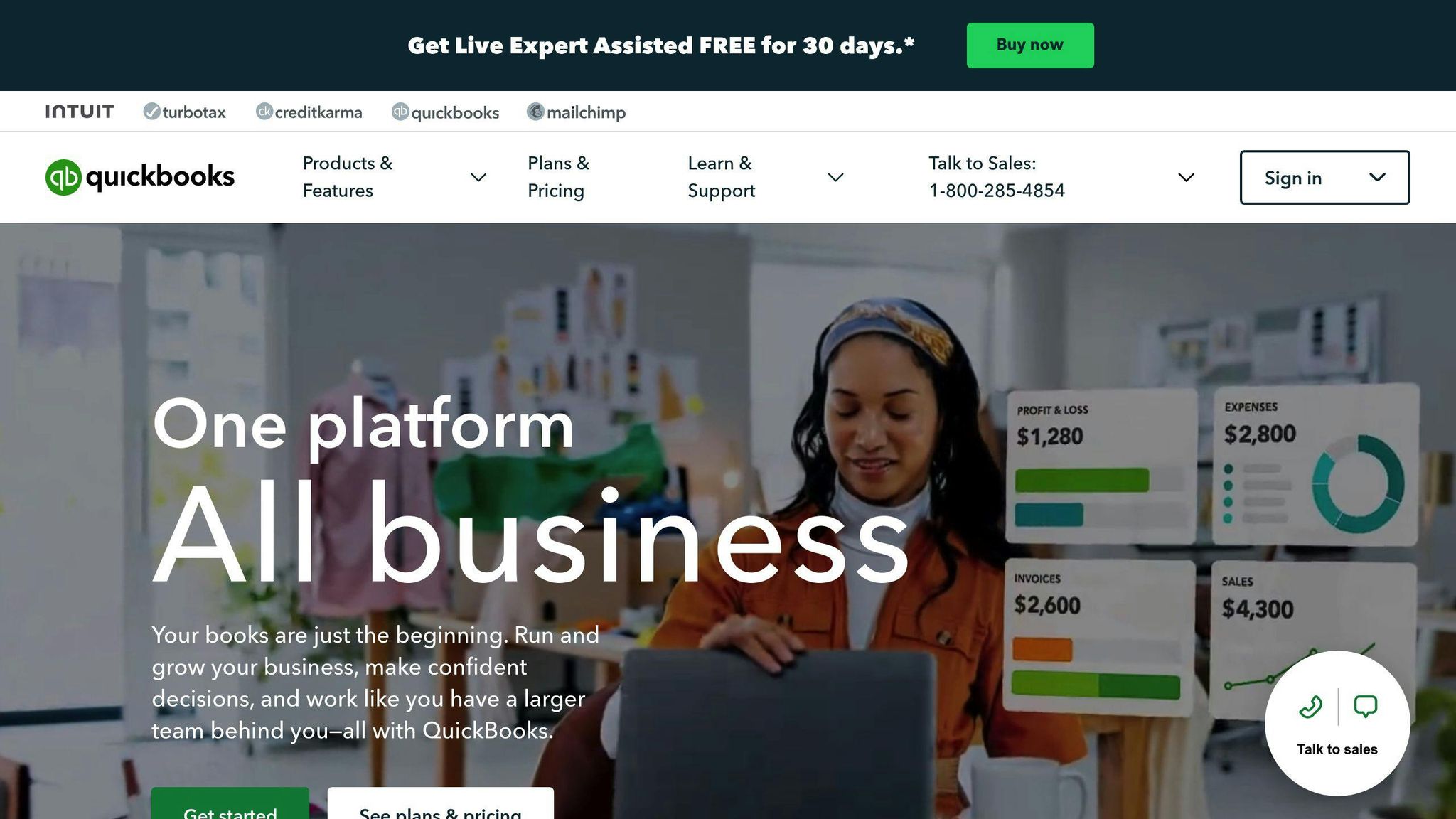
Intuit QuickBooks has become a key player in the B2B SaaS market, serving over 5 million customers globally with its financial management tools. Since its launch in 1983, QuickBooks has consistently evolved to meet the needs of small and medium-sized businesses.
The platform automates accounting, provides real-time financial dashboards, and simplifies operations with features like inventory tracking and project management. By reducing manual tasks by 70%, QuickBooks enables businesses to make smarter, data-backed decisions. Its ecosystem also integrates with more than 650 business apps, giving it a strong edge in the financial management space.
Here’s a closer look at what QuickBooks offers:
| Feature Category | Capabilities | Business Impact |
|---|---|---|
| Accounting Automation | Bank feed integration, AI-powered categorization | Cuts manual data entry by 70% |
| Financial Reporting | Real-time dashboards, customizable reports | Drives smarter decision-making |
| Business Operations | Inventory tracking, project management | Boosts workflow efficiency |
| Payment Processing | Multiple payment options, automated reconciliation | Enhances cash flow management |
Plans range from $30 to $200 per month, with the Plus plan ($85/month) being a favorite for growing businesses that need robust financial tools.
One standout feature is QuickBooks' AI-powered cash flow forecasting. By analyzing historical and recurring data, it predicts financial trends, helping businesses plan ahead. From retail to professional services, the platform is designed to work across different industries while remaining easy to use.
QuickBooks is a great example of how financial tools can improve efficiency and help businesses scale. For SaaS providers, it’s a lesson in solving specific customer challenges with AI and tailored features.
Strengths and Weaknesses of Each Company
Every B2B SaaS company has its own set of advantages and hurdles when catering to business customers. Here's a closer look at their standout qualities and challenges, based on market performance and user feedback.
| Company | Key Strengths | Key Challenges |
|---|---|---|
| Salesforce | • Flexible CRM solutions • Advanced AI tools (Einstein) • Extensive integrations |
• Steep learning curve for new users • Complex to implement • High pricing • Demanding for small businesses |
| HubSpot | • Easy-to-use, all-in-one marketing platform • Strong inbound marketing features • Budget-friendly starter plans |
• Lacks advanced features • Limited customer support • Expensive for enterprise users • Basic automation tools |
| Atlassian | • Effective team collaboration tools • Strong project management features • Affordable pricing |
• Complicated setup process • Requires technical knowledge • Complex interface • Limited features for business users |
| Slack | • Real-time collaboration tools • Strong search functionality • Simplifies team communication |
• Notification overload risk • Restrictions in the free tier • High costs at enterprise level • Challenges with organizing channels |
| Xero | • Accessible cloud-based platform • Tailored for small businesses • Automated accounting processes |
• Basic feature set • Slow support response times • Limited growth potential • Few customization options |
| QuickBooks | • Comprehensive financial tools • Industry leader • Advanced reporting features • $12.7B revenue in FY2022 |
• Difficult onboarding process • Premium pricing • Generic features for industries • Not beginner-friendly |
Each platform excels by targeting specific market demands while adapting to customer needs. For example, Salesforce stands out with its AI capabilities, while HubSpot's user-friendly design appeals to businesses seeking simplicity. These contrasts help businesses select the right tool based on their goals and technical expertise.
Key Lessons for SaaS Growth
The growth stories of top B2B SaaS companies like Salesforce and HubSpot offer valuable insights for emerging players. By analyzing their strategies, we can pinpoint what drives consistent success in this competitive space.
Understanding Customer Needs
Focusing on customer needs is critical for long-term growth. HubSpot excels here with its "all-in-one" approach, addressing common business challenges and earning a 98% customer satisfaction score. This focus on solving real problems keeps users engaged and loyal.
Building Scalable Solutions
A scalable business model is another cornerstone of success. HubSpot caters to businesses of all sizes, from individuals to large enterprises, with a tiered pricing model. Starting with free tools and scaling up to enterprise-level solutions, they make it easy for customers to grow alongside their platform.
| Growth Strategy | Example | Outcome |
|---|---|---|
| Freemium Model | Dropbox’s referral-based freemium plan | Fueled rapid user growth |
| Content Marketing | Chanty’s educational content | Attracted 70% of first 10,000 users |
| Email Marketing | Standard B2B SaaS approach | Achieves 4,200% ROI |
While scalability is essential, companies must also prioritize innovation and seamless integration to stay ahead.
Staying Innovative and Integrated
Market leaders consistently bring new ideas to the table while ensuring their platforms integrate smoothly with others. Shopify’s app marketplace, featuring over 3,700 apps, is a prime example of how integration options can boost adoption and retention.
"The B2B SaaS landscape is evolving rapidly, offering unprecedented opportunities." - Mosheh Poltorak, Growth Consultant
Expanding into New Markets
Strategic market expansion is another key growth driver. Salesforce’s success in India, where it reached $1 billion in revenue with 36% growth in FY2024, highlights the importance of selecting the right markets and adapting to local needs. Data plays a crucial role in refining these strategies and ensuring smooth execution.
Using Data to Drive Decisions
Top SaaS companies rely heavily on data to fine-tune their operations. Take Unbounce's "Smart Traffic" feature, for example - it uses data to increase customer conversions by 30%, showcasing how analytics can directly impact results.
These lessons underline the importance of combining customer-focused product development, scalable models, and consistent innovation to achieve lasting growth in the SaaS world.
FAQs
What is an example of a B2B SaaS company?
Here are some well-known B2B SaaS companies and what they offer:
| Company | Core Solution | Highlighted Feature |
|---|---|---|
| Salesforce | CRM Platform | Offers highly customizable solutions |
| HubSpot | Marketing & Sales | Combines tools into one platform |
| Atlassian | Team Collaboration | Supports over 180,000 customers |
| Slack | Communication | Focuses on advanced collaboration |
Each of these companies tackles specific business needs in its own way. Salesforce stands out with its ability to create tailored enterprise solutions. HubSpot simplifies marketing and sales with its integrated tools. Atlassian enhances team collaboration, while Slack changes how teams communicate with its user-friendly platform.
When choosing a B2B SaaS solution, businesses should consider factors like scalability, ease of integration, customer support, and pricing. For example, Slack offers a freemium model, allowing companies to try the platform before committing. Other providers may base pricing on features or the number of users, making it easier for businesses to scale as they grow.
These examples show how B2B SaaS companies solve business challenges in different ways. They also underline the importance of focusing on growth, flexibility, and customer needs when developing or selecting a solution.
Built by Artisan Strategies
Here at Artisan Strategies we both help companies accelerate their own revenue and launch our own products to improve your daily life. Whether it's for productivity (Onsara for macOS) or simply a better dictionary in Chrome (Classic Dictionary 1913), we've built something for you.